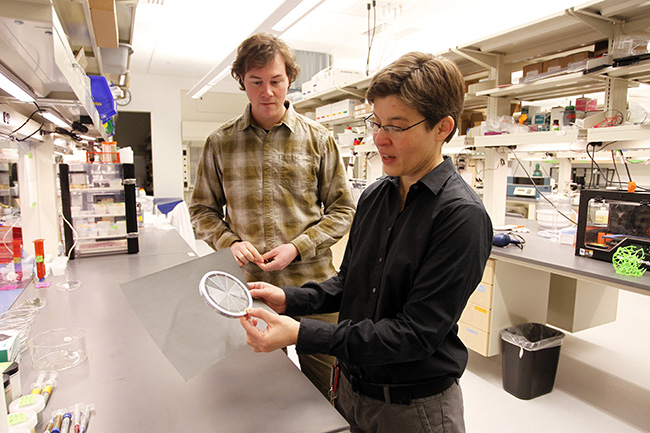News All News
March 16th, 2016
Harvard lab developing 3D ‘inks’ that can replicate human cells (Boston Globe)
Sophisticated multimaterial printers and novel inks promise advances in electronic devices and bioengineering
By Nidhi Subbaraman, Boston Globe

The laboratory of Prof. Jennifer A. Lewis specializes in developing novel "inks" for sophisticated 3D printers. With the help of Harvard's Physical Sciences & Engineering Accelerator, she has also founded a company, Voxel8, to commercialize the 3D printing of electronic devices.
A two-ton printer the size of a small car takes pride of place in Jennifer Lewis’s lab, among half a dozen machines arrayed in a basement on Harvard’s campus. But on a recent weekday morning the room is calm, with only the tunes from a Pandora station (“Lynyrd Skynyrd Radio”) piercing the calm.
Lewis, a professor at the Harvard John A. Paulson School of Engineering and Applied Sciences, is among a generation of engineers who are radically expanding the capabilities of 3-D printing.
That technology emerged about 30 years ago as a way to make fast, precise models of a car, or a plane, or a bridge, before building the real thing. The chief material by far was plastic, heated until molten, and then passed through a nozzle like really hot glue and laid down layer after layer to form a shape first modeled on software.
Decades on, the Lewis lab is in the business of making “ink” for 3-D printers, so that useful, functional objects made of a variety materials, not just plastic, can be produced. Loaded into a cartridge like an office printer, these materials aren’t sprayed on paper.
Instead, they are liquefied and extruded onto a base of choice, maybe paper, maybe metal, maybe a flexible polymer. The lab’s primary goal is to expand the type of objects that can be made in a 3-D printer.
“If we can make matter that affects people’s lives in a material way that would be a tremendous thing to accomplish,” Lewis said.
“Creativity is the limit here in terms of what’s possible,” said Michael McAlpine, a professor at University of Minnesota who is simultaneously working on printing living tissue and electronic inks. In a field in which researchers are racing to run every material imaginable through a printer, the Lewis lab has the edge in working with biological tissue. “She’s certainly a pioneer in doing that,” he said.
Read the entire article in the Boston Globe
Tags: bioengineering, Materials
Press Contact: Kirsten Mabry | (617) 495-4157
